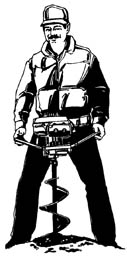Consider a Wood Fence |
|
| Few things complete
the exterior of a home like a beautiful wood fence. This impressive
structure is functional, too, providing privacy and keeping young
children or a dog in your yard. But perhaps the best thing about a wood
fence is that just about anyone with a bent for building can handle this
project.
Building a fence doesn't typically require fancy tools—just common hand tools, a circular saw and probably an earth auger. The difficulty depends on your terrain and the complexity of the fence you plan to build. A flat yard will be much easier to work with than an uneven one. This can be hard work at times. Fence posts are heavy and hole digging takes some endurance. A rented earth auger makes the job a whole lot easier. Power augers have a corkscrew design, so they literally pull themselves into the earth, saving time and effort over a manual digger. The operator just basically "steers". Power models come in one- and two-person versions, with different diameters and lengths for a variety of applications. Typically for fence and deck projects, the smaller version works best. As you work, you'll have to pull the auger partially out of the ground to remove the loosened dirt. For this reason, using this tool takes some strength; not everyone can handle it. And it works best in loose soil, with few rocks or roots. This article walks you through the initial steps prior to building. The actual construction will vary depending on the style of fence you choose. Fences range in complexity from the simplest prefabricated panel fence to a side-by-side board fence to an elaborate historical design. Consult books, magazine articles or Internet plans to choose the fence that's right for your yard. First, tell your neighbours that you plan to build a fence so you won't surprise or upset them unnecessarily. Then you'll want to find out the location of your property lines and underground utility lines such as gas, electric, or phone—your city government can help. This is important because the entire fence, including the footings around the posts, must be inside your property lines.
|
Check with utility companies
to determine the location of cables and pipes. They can come out and
mark the locations with spray paint. Check with your local building
officials to see if the building code regulates fences in any way,
including the height and distance from lot line.
Price out your fence. The cost of a wood fence project will vary depending on the style and type of wood. You're going to need concrete for the post footings. Figure roughly two 80-lb. bags per post if you're mixing it yourself. Otherwise it's about one yard of concrete for 40 posts. Don't forget to calculate the cost of paint or finish as well, when you check your budget. Map the fence out on the ground. Put up stakes and strings to mark the location of your fence posts. Then, make a map of your fence on graph paper, showing the length of each section. Calculate how far apart the posts will be for each section. The maximum distance between posts should be about 8 feet. If your fence is going to have a gate, decide on its location. Put the gate on as level a spot as possible, with the hinge on the downhill side. Note all of this on your map. Then, once you've planned, priced and mapped your fence, you're ready to order the materials. Stop by our store to rent a power auger and other power tools. If concrete footings are involved, we can rent a mixer and finishing tools. |
 |
|